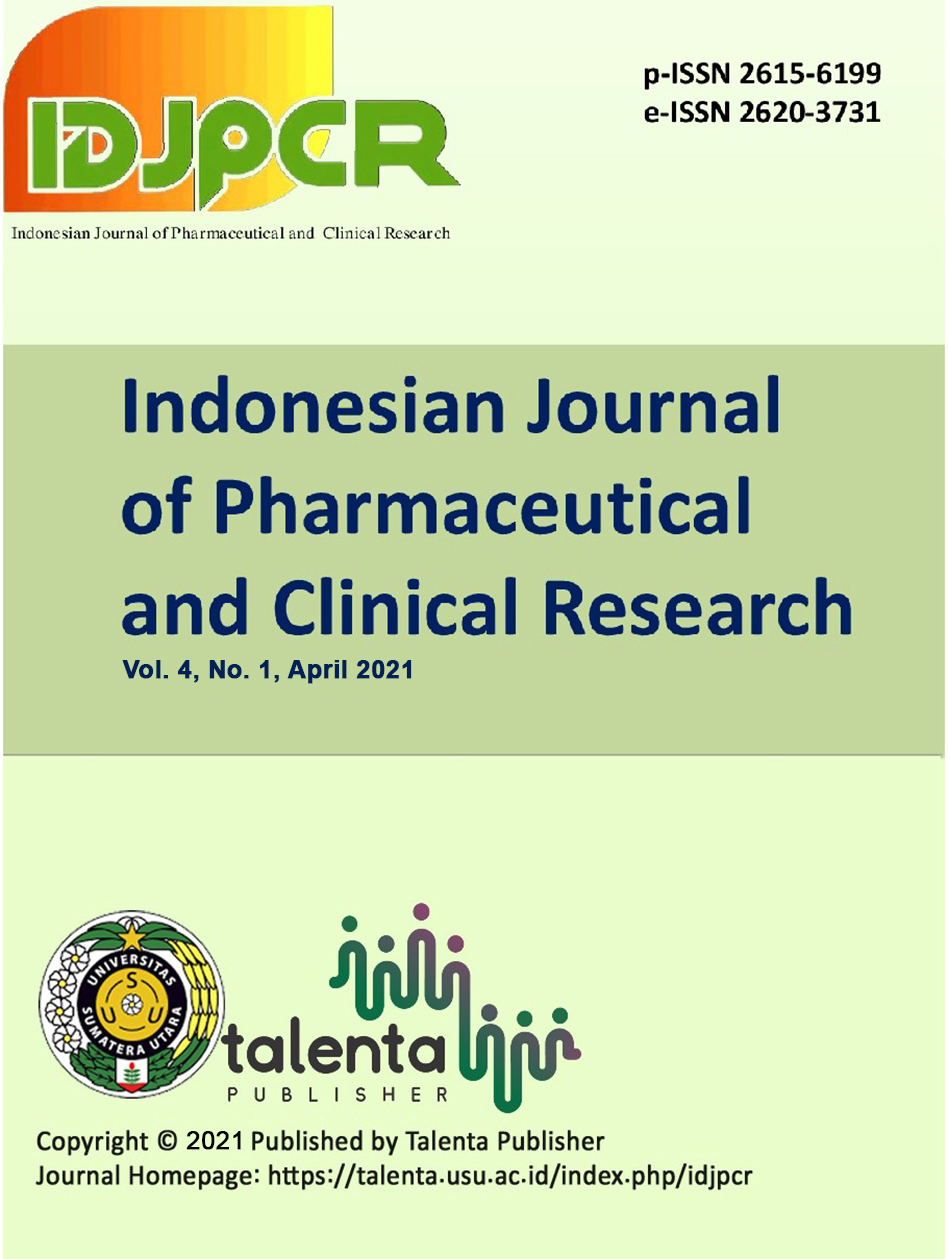Anti-Acne Activity From Biocellulose Mask Formula Containing (Aloe Vera (L.) Burm.F) Essence Combined With Vitamin E
DOI:
https://doi.org/10.32734/idjpcr.v4i1.5382Keywords:
Acetobacter xyllinum, Anti-acne, Biocellulose mask, Essence, Propionibacterium acne, Pseudomonas aeruginosaAbstract
Abstract. Biocellulose mask sheet is a new found pharmaceutical cosmetic design that widely commercial. Mostly due to it’s biodegradable properties, provide an eco-friendly waste. Combination of Aloe vera essence (AE) and Vit E to provide and determine it’s respective anti-acne properties in biocellulose mask form. Formulation of biocellulose mask with the help of Acetobacter xylinum bacteria varied with different formulae: F1 (Vitamin E 1%), F2 (E 2.5 %), F3 (AE 5%), F4 (AE 2.5%+Vit E 1%) and F5 (AE 5%+Vit E 1%) followed antimicrobials test with common acne bacteria by diffusion disk against Propionibacterium acne (PAC) ATCC 6919 and Pseudomonas aeruginosa (PAA) ATCC 27853. Study revealed that each formulae design F1; F2; F3; F4; F5 tested against PAC diffusion disk resulted 7.86; 11.67; 10.13; 112.10; 10.33 mm respectively. As for PAA diffusion disk resulted 7.76; 11.63; 10.33; 11.67; 11.00 mm respectively. Biocellulose mask containing combination of AE 2.5% and Vit E (F4) would provide the best anti-acne activity amongst other formulae.
Downloads
References
P. Perugini, M. Bleve, F. Cortinovis, and A. Colpani, “Biocellulose masks as delivery systems: A novel methodological approach to assure quality and safety,†Cosmetics, vol. 5, no. 4, 2018, doi: 10.3390/cosmetics5040066.
T. Amnuaikit, T. Chusuit, P. Raknam, and P. Boonme, “Effects of a cellulose mask synthesized by a bacterium on facial skin characteristics and user satisfaction,†Med. Devices Evid. Res., vol. 4, no. 1, pp. 77–81, 2011, doi: 10.2147/MDER.S20935.
R. A. Bojar and K. T. Holland, “Acne and Propionibacterium Acnes,†2004, doi: 10.1016/j.clindermatol.2004.03.005.
A. L. Perry and P. A. Lambert, “Propionibacterium acnes,†Lett. Appl. Microbiol., vol. 42, no. 3, pp. 185–188, 2006, doi: 10.1111/j.1472-765X.2006.01866.x.
D. G. S. Amar Surjushe, Resham Vasani, “ALOE VERA: A SHORT REVIEW,†Indian J. Dermatol., vol. 53, no. 4, pp. 163–166, 2008, doi: 10.4103/0019.
J. Reveny, J. Tanuwijaya, and M. Stanley, “Formulation and Evaluating Anti-Aging Effect of Vitamin E in Biocellulose Sheet Mask,†Int. J. ChemTech Res., vol. 10, no. 1, p. (322-330), 2017.
J. Reveny, Surjanto, J. Tanuwijaya, and C. Lois, “Formulation of aloe juice (Aloe vera (L) burm.f.) sheet mask as anti-aging,†Int. J. PharmTech Res., vol. 9, no. 7, pp. 105–111, 2016.
P. Perugini, M. Bleve, R. Redondi, F. Cortinovis, and A. Colpani, “In vivo evaluation of the effectiveness of biocellulose facial masks as active delivery systems to skin,†J. Cosmet. Dermatol., vol. 19, no. 3, pp. 725–735, 2020, doi: 10.1111/jocd.13051.
G. Pacheco et al., “Bacterial cellulose skin masks—Properties and sensory tests,†J. Cosmet. Dermatol., vol. 17, no. 5, pp. 840–847, 2018, doi: 10.1111/jocd.12441.
X. Guo and N. Mei, “Aloe vera: A review of toxicity and adverse clinical effects,†J. Environ. Sci. Heal. - Part C Environ. Carcinog. Ecotoxicol. Rev., vol. 34, no. 2, pp. 77–96, 2016, doi: 10.1080/10590501.2016.1166826.
Downloads
Published
How to Cite
Issue
Section
License
Copyright (c) 2021 Indonesian Journal of Pharmaceutical and Clinical Research

This work is licensed under a Creative Commons Attribution-ShareAlike 4.0 International License.
The Authors submitting a manuscript do so on the understanding that if accepted for publication, copyright of the article shall be assigned to Indonesian Journal of Pharmaceutical and Clinical Research (IDJPCR) and Faculty of Pharmacy as well as TALENTA Publisher Universitas Sumatera Utara as publisher of the journal.
Copyright encompasses exclusive rights to reproduce and deliver the article in all form and media. The reproduction of any part of this journal, its storage in databases and its transmission by any form or media, will be allowed only with a written permission from Indonesian Journal of Pharmaceutical and Clinical Research (IDJPCR).
The Copyright Transfer Form can be downloaded here.
The copyright form should be signed originally and sent to the Editorial Office in the form of original mail or scanned document.









